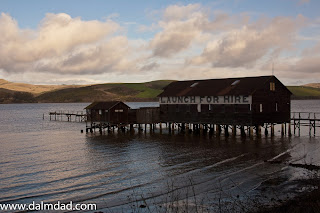by Steve Reiss (Dalmdad Landscape Photography - www.dalmdad.com and https://www.facebook.com/Dalmdad.)
 |
| A Ewe Dropping Some Pellets While Running Along a Rock Outcropping |
On Bighorn Sheep Pellets, Poop, and Scat...
Bighorn pellets may be deposited singly or in clusters. They may be strung out if the animal was walking or lie in a group if the animal was standing or lying down. They vary in shape, from a tiny apple seed to the large chocolate drop with attenuated tip and an indentation on the bottom.
Exterior color may be black, brown, or sometimes green and interior color may be green or brown. Some may have a pattern of alternating dark brown and light green. Pellets are mount externally when first dropped but soon dry to a varnished finish. They are dry internally, however, even when fresh.
Fred Jones says, to him, bighorn pellets are indistinguishable from those of domestic sheep and goats. He knows of no method by which bighorn and deer droppings can be consistently distinguished.
Determining the age of desert bighorn pellets is uncertain because of the variation in color, consistency, and degree of external varnish at the time of defecation and because of variation in weathering rates.
The figure of average pellets groups per acre provides a population-related index to average animal density.
The size of the pellets, generally, but not always, is related to the size of the animal. However, lambs dropping big loads and rams dropping small loads are not unknown.
...from Fred L. Jones, "Sign Reading and Field Identification", from The Desert Bighorn (Edited by Monson and Sumner) (1980)
More tidbits about pellets...
Pellets are probably the least understood and most misleading single factor in sign reading.
The Nelson bighorn leave remarkably few droppings behind them.
Freshness is of great importance in dropping analysis; and since there is very little moisture left in them when fresh, there is no way to tell how old they are except by seeing them drop.
The daily incidence of defecation is assumed by some to be about the same as in deer and domestic sheep, or around 14 times daily. However, the difference in the use of food in the acquisition and conservation of water precludes the validity of this assumption.
...from Welles, et al, The Bighorn of Death Valley (1961)
































